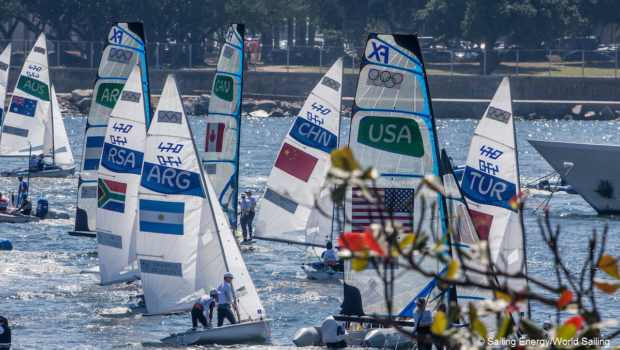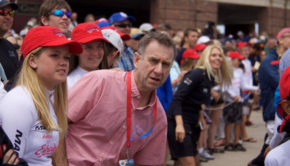Event Decisions for Tokyo 2020 Games
Published on August 28th, 2016
by Craig Leweck, Scuttlebutt
The ten Sailing events at the 2016 Olympic Games were supposed to continue on for Tokyo 2020, but a shifting wind from the International Olympic Committee (IOC) has forced World Sailing to retrim its sails.
The 2016 slate included five male events (470, 49er, RS:X, Laser, Finn), four female events (470, 49erFX, RS:X, Radial), and one mixed event (Nacra 17). While the hope is for minimal changes, nothing occurs without debate.
Decisions are expected in February, so planning for the 2020 Games is in a six month limbo period. Depending on your view, this is either catastrophe or opportunity. What must be expected, however, is that Sailing in the Olympics is in for a shift.
The challenge for Sailing will be to fulfill the IOC objectives without losing its soul. Here are some of the discussion items…
FORMAT
From the outside, all the Sailing events look too similar. We have ten events diving off the same 10m platform but wearing different bathing suits. For sailors, the differences are critical. For the other 95% of the people that watch the Games, not so much. Sailing needs more obvious variation in its events. A steady diet of similar boats on windward-leeward racing won’t cut it.
GENDER EQUALITY
Rio Olympics had 380 athletes across ten Olympic disciplines, but there were 217 men and only 163 women. The IOC wants more gender equality. With the Finn, there is already one extra male event. Also, in all the other events with male and female fleets, the limits were higher for men in all but the skiffs. Either through event selection or entry limits, we need more women. The issue, however, is that we can’t have more sailors overall. This translates to fewer men at the 2020 Games.
PARTICIPATION
There may be no other metric the IOC adores more than participation. Sailing had 66 nations, so the events that get selected will be mindful of this number. Bottom line is the Laser/Radial and RS:X events are secure. These events provide equipment and are where the small nations participate.
RULE MANAGEMENT
This will be a lingering thought in event selection. Olympic competition requires massive equipment control, and most of the current one design classes have problems. A new rules interpretation in the Finn drastically changed the hull. Questionable oversight in single manufacturer classes – Nacra 17, Laser/Radial, RS:X – impacts performance. Skiff tweaking is rampant. The 470, following only the Finn in seniority, offers the most confidence.
CHANGES
World Sailing is hoping for minimal changes from 2016, but that’s not the safe approach to insure a strong position in the Games. Here are some of the considerations…
Long distance race. Yes, this is being discussed. Overnight long. Keelboat long. Track has the marathon, and many iconic sailing races are long. Adventure and adversity are easy angles to share, and with the progress made on broadcasting these stories, this is an arguable no-brainer.
Kiteboards. They are coming to the Games. They are cool, they have hydrofoils, and the sailors are athletic (and attractive). Kite events already have a multitude of formats such as freestyle, wave, slalom, and speed. This is the easiest way for World Sailing to introduce alternative formats.
Race course length. The new Olympic course will get shorter. Action is the buzzword, and the skiffs with their 30 minute races have action. The Finn race was 50 minutes, which provides for a strategic, grind it out contest, but is lethargic for the spectator. Race course types need to change too. More reaching is required. Critics might call them parades, but planning boats on reaches look cool.
Foiling. Everybody says it’s the future but fail to point out its limitations. Foiling boats need to foil, which means they can’t race in light air. They also can’t race in heavy air, as they tend to suffer in sea state. Already at the Rio Olympics, half the events couldn’t handle the ocean race area when it got windy. This was disruptive to course assignments and broadcast schedule. Foiling kiteboards have best handled this conundrum.
Medal Race. The non-discard, double-points finale was intended to insure the podium would be in question until the very end. But in Rio, four champions had the points to secure gold in advance. For the other six events, four years of preparation were placed on a highly fickle race area to determine results. While the Medal Races were exciting to watch, that tends to translate it was random racing for the competitors. A tweak to the system would be for the sailors; status quo would be for the IOC.
Multiple medals. Sailing is one of the few sports where each athlete has only one medal opportunity. Creating an event schedule with more opportunities creates for more story angles, and the IOC likes its sports to have multiple discussion points.
GRADING THE CURRENT EVENTS
470 Men and Women: This event provided some of the closest, most tactical racing. However, this technical one design class should be worried. While this is a boat every sailor can relate to, it is also why the other 95% of the viewers can’t appreciate it. Keeping the 470 will retain sailing’s soul but may depend on other event decisions.
Finn: I don’t know how this event survives the cut. Gender balance is a big deal, and the Finn currently has no female event to level the numbers. This would be a shame as these guys are athletic specimens that demonstrate raw power on the race course. The Finn’s survival may depend on what other events make the cut.
Laser Men and Radial Women: These events are guaranteed as they secure broad participation.
RS:X Men and Women: There might be an adjustment in equipment but otherwise these events are guaranteed as they secure broad participation. Thought might be given for multiple heats like track to provide excitement and an obvious path toward the finals.
49er Men and 49erFX Women: These events are secure as they provide excitement. Their races are short, the boats look appealing, and they have speed to burn. With so much reaching downwind, they mask the fact that they are on a staid windward-leeward course.
Nacra 17: These boats were designed before foiling became mainstream, so talk now is to retrofit them with fully foiling packages. Problem is these boats are built poorly, so construction changes would be needed to accommodate the design shift. This translates to every current boat being trashed…not a good option. World Sailing should either live with them as is or pick a new boat, but otherwise I expect a multihull event to be secure.
Note: Additional analysis of these 10 events can be found here.
OLYMPIC BRAND
Event changes are highly disruptive to the one design classes involved. However, the Olympic Brand is disruptive too as more demands are placed on the classes. For older classes like the 470, Finn, and Laser/Radial, survival does not hinge on their Olympic involvement. Just ask the Star. The other classes, however, would disappear if cut from the Games. Unfortunately, the whims of the IOC cannot be ignored. The decisions made in February will say a lot about how secure World Sailing believes is its place in the Olympic Family.









 We’ll keep your information safe.
We’ll keep your information safe.